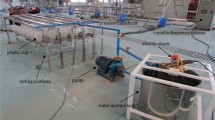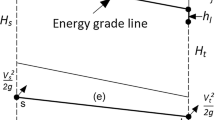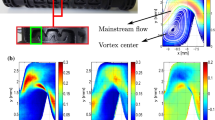Abstract
At present, the tortuous emitter has the most advanced performances in drip irrigation. But the theories and methods for designing its flow path have been strictly confidential and the researches on the function of practical guidance have seldom been published. Seven types of most representative tortuous emitting-pipes currently used in agricultural irrigation regions of China were chosen for investigating the geometric parameters of the flow path by means of combining high-precision microscope and AutoCAD technology. By the measurement platform developed by the authors for hydraulic performances of emitters, the free discharge rates from the 7 types of emitters were measured at 9 pressure levels of 1.5 m, 3.0 m, 5.0 m, 7.0 m, 9.0 m, 10.0 m, 11.0 m, 13.0 m and 15.0 m. Then the discharge-pressure relationship, manufacturing variation coefficient, average velocity on the cross-section of flow path and the critical Reynolds number for the flow regime transformation within the paths were analyzed in detail. The results show that both pressure-ascending work pattern and pressure-descending work pattern have some impacts on the discharge rates of tortuous emitters, but the impact level is not significant. The target pressure could be approached by repetitive applications of the two work patterns during pressure regulation. The operation under low pressures has some impacts on the hydraulic performances of emitters, but the impact level is also not significant. The classical model of the discharge-pressure relationship is suitable for the pressure range of 1.5 m –15.0 m. The Reynolds number for fluids within the 7 types of tortuous emitters ranges from Re =105 to Re =930. The critical Reynolds number for the flow regime transformation is smaller than that for the routine dimension flow path. The variation coefficient of emitter discharge rates is slightly fluctuating around a certain value within the whole pressure range.
Similar content being viewed by others
References
DASBERG S. and OR D. Drip irrigation [M]. New York, Berlin, Heidelberg: Spinger, 1999.
LI Yun-kai, YANG Pei-ling, REN Shu-mei et al. Analyzing and modeling flow regime in labyrinth path drip irrigation column emitter with CFD [J]. Journal of Hydrodynamics, Ser. A, 2005, 20 (6): 736–743. (in Chinese)
LI Jiu-sheng, ZHANG Jian-jun and XUE Ke-zhong. Principle and application of drip irrigation fertilization[M]. Beijing: China Agricultural Science and Technology Press, 2003. (in Chinese)
YANG Pei-ling and LEI Xian-long. Development and research of drip irrigation emitters[J]. Water Saving Irrigation, 2000, (3): 17–19. (in Chinese)
HAN Quan-li, ZHAO Wan-hua and DING Yu-cheng. Status quo and analysis of drip irrigation emitters [J]. Water Saving Irrigation, 2003, (1): 17–18. (in Chinese)
KAMRMLI D. Classification and flow regime analysis of dripper[J]. Journal of Agricultural Engineering Research, 1977, 22 (2): 165–173.
TAL S. and ZUR B. Flow Regime in helical long-pathemitter[J]. Journal of Irrigation and Drainage Division ASCE, 1980, 106 (IR1): 27–35.
GIDEON G. G. Gravity drip irrigation System[A]. Proceedings of the 3rd International Drip/Trickle Irrigation Congress [C]. Fresno, California, USA, 1985, 50–57.
OZEKICI B. and RONALD S. Analysis of pressure losses in tortuous-path emitters[M]. Albuquerque, New Mexico, USA: America Society of Agriculture Engineering, 1991, 112–115.
FANG Bu-ling and ZHAO De-lin. Research on the emitters of wafer-like tortuous flow path [A]. Proceedings of the Cultivating Mechanical Institute[C]. 1997, 145–150. (in Chinese)
POTTER M. and WIGGERT D. Mechanics of fluid [M]. Boston: Elsevier Academic Press, 2003.
JONES O. Turbulent friction in rectangular ducts[J]. Journal of Fluids Engineering, 1976, 98 (1): 173–180.
DEPARTMENT OF INTERNATIONAL COOPERATION AND SCIENCE AND TECHNOLOGY OF WATER RESOURCES MINIST. Compilation of water conservancy technology standards-volume of irrigation and drainage (water saving equipment and materials) [S]. Beijing: China Water Conservancy and Hydropower Press, 2002, 32–54. (in Chinese)
GLAAD Y. K. and KLOUS L. Z. Hydraulic and mechanical properties of drippers[A]. Proceedings of the 2nd International Drip Irrigation Congress[C]. San Diego, Calofornia, USA, 1980, 7–14.
REN Shu-mei and YANG Pei-ling. Preliminary research on the soil moisture dynamics in the mountainous orchards with gravity drip irrigation and the irrigation scheduling for the fruit trees[J]. China Water Conservancy and Hydropower in Rural Region, 2002, 31 (1): 20–22. (in Chinese)
SALVADOR P. G., ARVIZA V. J. and BRALTS V. F. Hydraulic flow behaviour through an in-line emitter labyrinth using CFD techniques[A]. ASAE/CSAE Annual International Meeting[C]. Ontario, Canada, 2004.
PFAHLER J., HARLEY J., BAU H. H. et al. Liquid transport in micro and submicron channels[J]. Sensors and Actuators, 1990, A21–A23: 431–434.
PENG X. F., PETERSON G. P. and WANG B. X. Friction flow characteristics of water flowing through rectangular micro channels [J]. Experimental Heat Transfer, 1994, 7 (4): 249–264.
XIN Ming-dao and SHI Jin-sheng. Experiment on the performances of stressed convection and heat-exchange in small rectangular paths [J]. Transaction of Chongqing University, 1994, 17 (3): 117–122. (in Chinese)
JIANG Ming-jian and LUO Xiao-hui. Research on the single-phase convection and heat-exchange of water in the micro-dimension paths [J]. Transaction of Beijing United University, 1998, 12 (1): 71–75. (in Chinese)
HUANG De-bin, DENG Xian-he and WANG Yang-jun. Numerical simulation study of turbulent drag reduction over ribelt surfaces of tubes [J]. Journal of Hydrodynamics, Ser. A, 2005, 20 (1): 101–105. (in Chinese)
QU Jian-wu, MURAI Yuichi, YAMAMOTO Fujio. Simultaneous PIV/PTV measurements of bubble and particle phases in gas-liquid two-phase flow based on image separation and reconstruction [J]. Journal of Hydrodynamics, Ser. B, 2004, 16 (6): 756–766.
Author information
Authors and Affiliations
Corresponding author
Additional information
Project supported by the National Natural Science Foundation of China (Grant No: 50379053) and the National High Technology Development Key Project (863) (Grant No: 2002AA6Z3091).
Biography: LI Yun-kai (1975-), Male, Ph. D., Lecturer
Rights and permissions
About this article
Cite this article
Li, Yk., Yang, Pl., Ren, Sm. et al. Hydraulic Characterizations of Tortuous Flow in Path Drip Irrigation Emitter. J Hydrodyn 18, 449–457 (2006). https://doi.org/10.1016/S1001-6058(06)60119-4
Received:
Published:
Issue Date:
DOI: https://doi.org/10.1016/S1001-6058(06)60119-4




